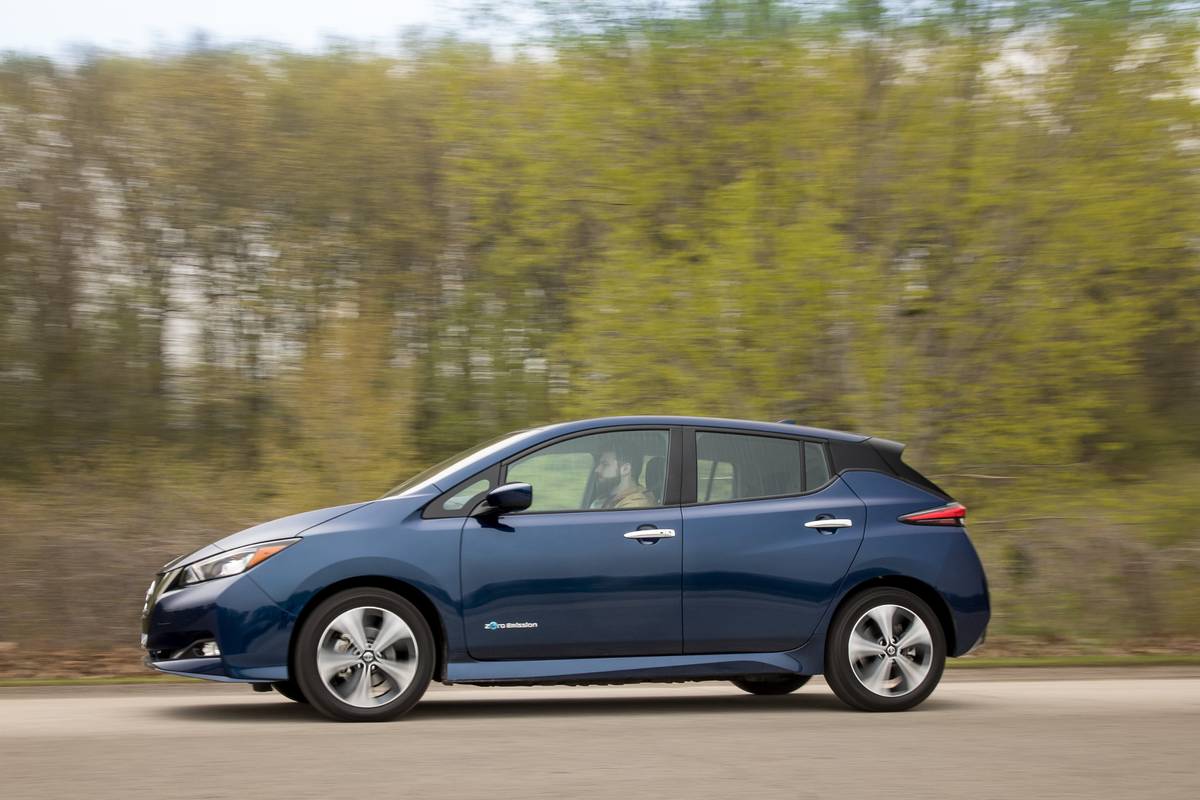2019 Nissan Leaf Plus Quick Spin: Beating Back Range Anxiety


Range anxiety is real. I had firsthand experience with it courtesy of a 2011 Nissan Leaf, a car Cars.com owned for more than a year to better understand what it’s like to live with an electric car. The 2011 Leaf’s EPA-estimated driving range was just 73 miles on a full charge, which meant you didn’t need to travel far before thinking about how you’d make it back.
The Leaf’s range has steadily improved since its debut, with the biggest year-over-year increases coming in the two most recent model years: The redesigned 2018 Leaf got a higher-capacity 40-kilowatt-hour battery pack good for 150 miles of range, according to the EPA, and a new Leaf Plus with a 62-kwh battery pack and up to 226 miles of range joined the lineup as a 2019 model. We took a 2019 Leaf SV Plus for a quick spin at the Midwest Automotive Media Association’s spring rally in Elkhart Lake, Wis., to see what the new long-range Leaf is like to drive.
We’ve Seen This Movie Before
Perhaps not surprisingly, the Leaf Plus driving experience is much the same as the regular Leaf’s. Light-effort steering is the order or the day, and the Leaf Plus felt quick enough with three people aboard; it easily accelerated up to midrange speeds, and its electric drivetrain delivers smooth, quiet power. The brake pedal has a bit of an artificial feel, but it’s relatively linear.
The new Leaf Plus makes considerably more horsepower than the regular Leaf; it’s rated at 214 horsepower, while the regular Leaf makes 147 hp. However, the Leaf Plus is also around 350 pounds heavier. Both versions use the same electric motor to drive the front wheels, but the Leaf Plus’ higher-capacity battery pack supports the greater output. According to Jeff Wandell, communications manager at Nissan, the Leaf Plus’ increased horsepower is most noticeable at highway speeds with increased passing performance. Our route consisted of mostly two-lane country roads, so we didn’t get a chance to test that claim.

Like the regular Leaf, the Leaf Plus is a firm-riding car; you feel bumps and cracks in the road. All in all, I’d prefer a softer setup — especially considering this isn’t a performance-oriented electric car.
Charging Details
The Leaf and Leaf Plus both come standard with a 6.6-kilowatt onboard charger, and the Plus gets a standard DC fast-charging port that’s optional on the regular Leaf. On 240-volt service, the Leaf Plus takes about four hours longer to charge: 11.5 hours versus 7.5 hours for the regular Leaf. DC fast-charging times are nearly identical — 45 minutes to 80 percent capacity for the Leaf Plus versus 40 minutes for the regular Leaf — because the Leaf Plus’ bigger battery can accept 100 kilowatts at a capable charger rather than the regular Leaf’s 50 kilowatts. The Leaf Plus takes 60 minutes for 80 percent capacity on 50 kilowatts.
More From Cars.com:
- 2018 Nissan Leaf e-Pedal Tested: Getting to Work Without Working the Brakes
- Hyundai Kona Electric Vs. Chevrolet Bolt EV: Which Is the Better Electric Car?
- Research Electric Cars
- Shop for a New Nissan Leaf
Final Thoughts
The Leaf S Plus is the least expensive trim level with the higher-capacity battery pack, and it starts at $37,445 including an $895 destination charge, but not including any federal or state incentives. That’s within a few hundred dollars of the base price of the 238-mile 2019 Chevrolet Bolt EV and 258-mile 2019 Hyundai Kona Electric, but the Bolt EV is no longer eligible for the full $7,500 federal tax credit that remains available for the Leaf as of publication, and the Kona Electric is only available in select states.
But is the Leaf Plus’ 76 miles of additional range worth its $6,560 price premium? That extra range would have been especially welcome in the Leaf’s early years, but the 2019 model’s 150-mile rating has largely made range anxiety a distant memory (at least for most trips). If you have an extremely long commute — or you just like the extra cushion that comes with a larger battery pack — the Leaf Plus might make sense. For everyone else, the regular Leaf should be enough. We plan to spend more time testing the Leaf Plus’ range and charging capabilities at a later date, so stay tuned.
Cars.com’s Editorial department is your source for automotive news and reviews. In line with Cars.com’s long-standing ethics policy, editors and reviewers don’t accept gifts or free trips from automakers. The Editorial department is independent of Cars.com’s advertising, sales and sponsored content departments.

Mike Hanley has more than 20 years of experience reporting on the auto industry. His primary focus is new vehicles, and he's currently a Senior Road Test Editor overseeing expert car reviews and comparison tests. He previously managed Editorial content in the Cars.com Research section.
Featured stories




